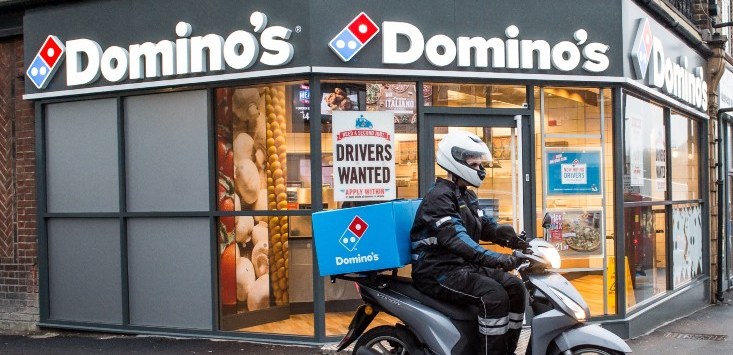
Source: PA Media/Domino's.
Fast delivery is the single most important part of the Domino’s experience. In fact, delivery is central to the brand’s DNA. History will tell you that pizza was the first food to be delivered door to door, and thus has the iconic status of fast, timely delivery — or your money back.
In this sense, the delivery takes precedence over the product itself. Customers have no reason to doubt that unless your pizza is stolen, blown away or eaten by someone else that your delivery won’t arrive. It is guaranteed. You would never find a customer waiting for weeks on end for their pizza, or having to spend hours on the phone to customer service to find out where it is.
If the pizza industry can get it right, why are so many others struggling?
In recent months we have seen delivery drivers striking at the huge pressures put on the workforce. The unreasonable demands from e-commerce sales and pickup pauses from the likes of Australia Post have meant that online purchases are not only delayed for weeks on end, but some don’t arrive at all.
When did delivery become less important than the product, and is it too late to get pizza-delivery-style delivery back on track? As the country looks to bounce back from the COVID-19 pandemic, it is time that retailers accept that the landscape has changed. We need to learn a thing or two from the pizza delivery boy.
Business focus has changed
In a flurry to increase brand awareness, for a fast rise to entrepreneurial fame or to recover from a pandemic puncture, businesses all across Australia have become less focused on how their products actually get to their customers.
Revenue has been put before logistics and a lack of revenue — or desperation to keep cash flow high — has led to robust logistics processes being ignored. End to end service, failed.
This approach has proven to be a huge mistake. Businesses can no longer rely on the stock-standard delivery systems that once kept their deliveries running smoothly. Australia Post and partnering delivery giants have already announced — three months ahead — that Christmas orders will be delayed, threatening to derail thousands of large and small businesses across Australia from fashion outlets to beekeepers. But could this be avoided?
Delivery and online shopping demands have changed
In a recent online consumer shopping report conducted by Zoom2u on consumer online shopping habits and delivery preferences, 71% of online shoppers stated that they would be more inclined to shop online more often if they could guarantee their purchase could arrive the same day. For retailers, that’s a potential 71% increase in sales, simply by improving their logistics processes. To make this happen, businesses can’t rely on the bigger delivery partners, because they simply don’t have the logistics in place to be able to offer this service.
The survey also revealed that a staggering 86% of online shoppers said that they would be less likely to order from a retailer again if they’d had a bad delivery experience. That’s an 86% chance that retailers and e-commerce sites are ruling out the chances of repeat purchases simply by avoiding this crucial area of the business.
It is time for retailers and e-commerce to change
So what’s the hold up? Many retailers are unaware that moving delivery in house doesn’t cost the earth. Often the easier option is to look to an external delivery driver to pick up the slack, but businesses are left out of pocket when something goes wrong.
More and more we are seeing retailers and food chains boycott typical methods of delivery to put their customers’ needs first. Take Bing Lee, for example, who knows the importance of being able to track the delivery of important, large items such as appliances and white goods. Few households can last longer than two days without a fridge, or four days without a washing machine and so delivery for these items are essential, and needs a guaranteed end to end service.
Large-scale retailers in the UK such as ASOS and Amazon offer delivery same-day, next day or in as little as a few hours, which they know will help to build confidence with their customers and guarantee repeat purchases. Australia is catching up for a handful of retailers (enter The Iconic and Nespresso), but they still have a long way to go.
It can be argued that the size of Australia is a key barrier to this, and that the two nations can’t be compared, but this isn’t necessarily the case. Amazon Flex is a prime example of a business looking internally for a solution. By identifying the needs of their customers first — that guaranteed pizza delivery — and tapping into a local resource of delivery drivers, they have been able to build networks of local drivers which enable them a faster, national delivery offering.
But the reality is, you don’t need to be a globally recognised super-power like Amazon to build your own, reliable, internal delivery system.
Delivery in general needs to change
The beauty of DIY delivery is not only guaranteed customer satisfaction, but the ability to tailor your delivery service to whatever you need it to be.
The pandemic has been a breeding ground for innovation and start-ups. In fact, businesses which started from home were up by 60% in 2020 compared to 2019. COVID-19 saw trends emerge that we didn’t think would ever be ‘a thing’.
Working from home, telehealth and all things contactless have all moved from a ‘pandemic convenience’ to an efficient way to live ongoing, and online shopping and delivery is much the same.
In nine of 13 major countries surveyed by McKinsey, at least two thirds of consumers said that during the pandemic, they had tried “new ways of shopping”. Out of these 13, 65% said that they would continue to do so. As much hype as there has been around freedom day, and the ability to head into the CBD to shop, a very large portion of Australian consumers will stick with their new-found online shopping habits and retailers should be prepared to deliver the goods — on time and fast — if they want to stay ahead of competitors.
I’m bringing pizza back
Amid the post-COVID carnage and re-entry into a version of normal, retailers must prioritise their customers and take time to reflect on old values or methods that may seem archaic, but go the distance.
Consumers and businesses alike are now crying out for easy-to-use, reliable, trackable, affordable and flexible delivery solutions, and they’re finally here at the click of a button, whether you deliver by boat, bike or car. It is not too late to build your own robust delivery service before the Christmas boom.
Handpicked for you

Click-and-collect: How a quick pivot helped AMR Hair and Beauty triple its e-commerce business



COMMENTS
SmartCompany is committed to hosting lively discussions. Help us keep the conversation useful, interesting and welcoming. We aim to publish comments quickly in the interest of promoting robust conversation, but we’re a small team and we deploy filters to protect against legal risk. Occasionally your comment may be held up while it is being reviewed, but we’re working as fast as we can to keep the conversation rolling.
The SmartCompany comment section is members-only content. Please subscribe to leave a comment.
The SmartCompany comment section is members-only content. Please login to leave a comment.